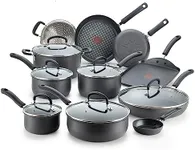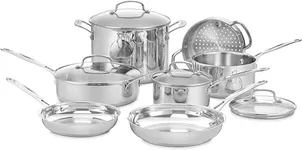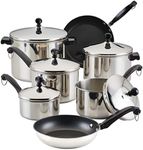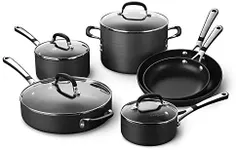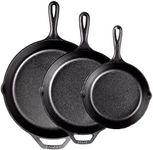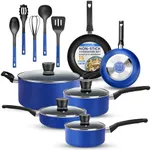Buying Guide for the Best Pot And Pans
Choosing the right pots and pans can significantly enhance your cooking experience. The right cookware can make a difference in how your food cooks, how easy it is to clean, and how long it lasts. When selecting pots and pans, consider your cooking habits, the types of dishes you prepare most often, and your kitchen setup. Here are some key specifications to consider when making your choice.MaterialThe material of the pots and pans affects heat conductivity, durability, and ease of cleaning. Common materials include stainless steel, non-stick, cast iron, and copper. Stainless steel is durable and resistant to rust and staining, making it a good all-purpose choice. Non-stick pans are great for low-fat cooking and easy cleanup but may not be as durable. Cast iron retains heat well and is excellent for slow cooking and searing, but it requires more maintenance. Copper offers excellent heat conductivity but can be expensive and requires regular polishing. Choose a material based on your cooking style and maintenance preferences.
Size and ShapeThe size and shape of pots and pans determine what and how much you can cook. Larger pots are ideal for soups, stews, and boiling pasta, while smaller pans are perfect for frying eggs or making sauces. Consider the types of meals you prepare most often and select sizes that match your needs. A variety of shapes, such as deep pots for boiling and shallow pans for frying, can provide versatility in your kitchen.
Heat ConductivityHeat conductivity refers to how evenly and quickly a pot or pan heats up. Materials like copper and aluminum are excellent conductors of heat, ensuring even cooking and reducing hot spots. Stainless steel, while durable, is not as good at conducting heat unless it has an aluminum or copper core. If you often cook dishes that require precise temperature control, such as delicate sauces or searing meat, prioritize pots and pans with good heat conductivity.
Handle Comfort and SafetyThe handles of pots and pans should be comfortable to grip and stay cool to the touch. Look for ergonomically designed handles that provide a secure grip. Some handles are designed to be oven-safe, which can be useful for recipes that start on the stovetop and finish in the oven. Ensure that the handles are securely attached to avoid accidents while cooking.
Lid Fit and MaterialLids help to retain heat and moisture, which is essential for certain cooking methods. A well-fitting lid can improve cooking efficiency and prevent spills. Lids can be made of the same material as the pot or pan, or they can be glass, allowing you to monitor your food without lifting the lid. Choose lids that fit snugly and are easy to handle.
Compatibility with CooktopsNot all pots and pans are compatible with every type of cooktop. For example, induction cooktops require cookware with a magnetic base. Check the compatibility of the cookware with your cooktop type, whether it’s gas, electric, ceramic, or induction. This ensures that your pots and pans will work efficiently and safely with your stove.
Ease of CleaningConsider how easy it is to clean the pots and pans. Non-stick surfaces are generally easier to clean but may require special care to avoid scratching. Stainless steel and cast iron can be more challenging to clean but are often dishwasher safe. If you prefer low-maintenance cookware, look for options that are dishwasher safe and have easy-to-clean surfaces.
DurabilityDurability is important if you want your cookware to last for many years. Stainless steel and cast iron are known for their longevity, while non-stick coatings may wear out over time. Consider how often you cook and the types of dishes you prepare. If you cook frequently, investing in more durable cookware can be worthwhile.
